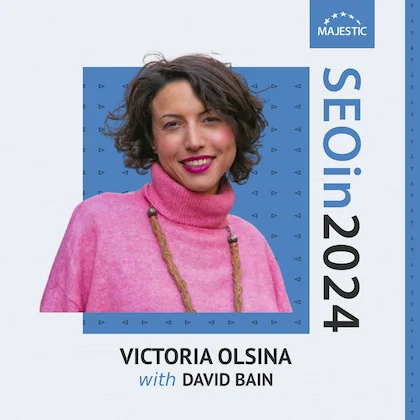-
Site Explorer
- Majestic
- Summary
- Ref Domains
- Backlinks
 New
New Lost
Lost- Context
- Anchor Text
- Pages
- Topics
- Link Graph
- Related Sites
- Advanced Tools
- Author ExplorerBeta
- Summary
- Similar Profiles
- Profile Backlinks
- Attributions
- Compare
-
Link Tools
- My Majestic
- Recent Activity
- Reports
- Campaigns
- Verified Domains
- OpenApps
- API Keys
- Keywords
- Keyword Generator
- Keyword Checker
- Search Explorer
- Link Tools
- Bulk Backlinks
- Neighbourhood Checker
- Submit URLs
- Experimental
- Index Merger
- Link Profile Fight
- Mutual Links
- Solo Links
- PDF Report
- Typo Domain
- Free SEO Tools
-
Support
- Blog

- Support
- Get started
- Tools
- Subscriptions & Billing
- FAQs
- Glossary
- How To Videos
- API Reference Guide

- Contact Us
- About Backlinks and SEO
- SEO in 2024
- Link Building Guides
- Webinars
- Blog
Build your own prompt libraries for your clients
Victoria Olsina
SEO Consultant and Speaker Victoria Olsina says that having a single prompt library might not be enough. You need multiple prompt libraries, one for each client.

Build your own prompt libraries for your clients
Victoria says: “Build your own prompt libraries, using AI and the voice and instructions of your clients, to produce the different content typologies that they need.”
Why does an SEO need to do this?
“Right now, AI can’t do this. I don’t know if, in a week’s time, we will have an AI that can automatically act like a client and replicate how they write, their tone of voice, and their unique selling proposal. It is possible, but I can only talk from my perspective today. So far, I haven’t seen any AI that can do that.
You can use the link reader plugin in GPT-4 to read different URLs, and therefore prompt the AI to write like a client by giving some samples – but you still need the samples.”
What does a great prompt library look like and what content are you building prompts for?
“Great prompt libraries are instructions that aim to produce their most popular content typologies faster. For example, newsletter intros, blog posts, and social media posts.
For B2B, the most important social media platform is LinkedIn. When you are creating your LinkedIn prompts, you need to consider how you would write about a topic. What’s your tone of voice? How does this brand talk to their audience on LinkedIn? For that, you need to define the audience. It’s not the same for a client in crypto compliance as it is for a client in automation testing. Developers and compliance officers talk in a different way.
Another very popular content typology would be product pages. Different clients talk about their products differently. The way that the CTA displays and the USP are different. Press releases, reports, and guides are also important. If you have the Ultimate Guide to Crypto Compliance or the Ultimate Guide to Automation Testing, they will look quite different.
Each type of content will need different prompts because the output is different. A LinkedIn post is different from a quarterly report or an Ultimate Guide to…”
Where would you keep this library and how often would you update the prompts?
“The most basic place to host these libraries would be a Google Doc or within Notion. It’s basically a Word doc.
As for how often you update them, it depends on the client’s needs. It’s very rare that the prompt is 100% perfect the first time that you try it. You have to refine it up to the point where the client is happy, then iterate and use it for one or two months. Then, if the client has feedback, you can incorporate the feedback and alter the prompt.”
How do you decide on the right prompts and the right way to use AI for a client’s content?
“It’s in agreement with the client. It’s a joint effort and a joint decision. You say to them that you can create a model, a framework, and a prompt that will help speed up the process of creating the kind of content they produce all the time.
In order to create those prompts, I sit with the client and ask them what their content is. I ask if there is any piece of content that they don’t like doing or they feel takes a lot of time and they could be doing something else that is more valuable to them.
For example, newsletter intros. Clients might say, ‘I really don’t like doing them. It takes me a lot of time, and it takes me away from things that are more important and would deliver more value to the business. Can you help me create them, so I don’t have to?’”
Do you use these prompts at the beginning of each conversation that you have with AI?
“It depends on how the prompt is structured. If you need to give examples, you can give them before or after, but the prompt has instructions for that.”
How do you ‘prime’ the AI?
“Priming the AI could be to say, ‘Act like X persona’, and X persona has a number of attributes and gives certain context. What’s more important, though, is to give examples. If you have a client who wants to automate the process of creating newsletter intros, you need 3, 5, or 10 examples of the introductions that they like. If they don’t have their own, then ask them to give 5 examples of their competitors’ newsletter intros that they like.
This is even more important than saying ‘Act like…’ because, if you give examples, the AI can identify the tone of voice, whether they are talking about a certain matter in an informal way or a formal way, etc. It can infer a lot of things from the example itself.
When you’re giving an example, providing a link is often faster than copying the text into the tool. You can give a link to 10 Google Docs, and each Google Doc could contain 10 client pages with 3,000 words on each page. If you try to copy and paste that same amount of content, it might stop working.”
Is this just for GPT-4 or is it for other AI software as well?
“You can create your own prompts on most platforms. Jasper and Writesonic have the ability to create your own prompt, and they have had this functionality for a long time. I mostly use ChatGPT because it’s the most flexible, and you can use them with the AIPRM plugin.
AIPRM is a Chrome extension that gives you a collection of prompts and allows you to store your own prompts as well. If you save your prompts there, you can then send the link to the client. The client doesn’t even have to see the prompt if you don’t want that.”
Once the AI starts creating content that you’re happy with, can you keep coming back to the same conversation and get the same results?
“I have had varied results with that approach, actually. When it’s reading or using a file that you upload, it tells you that it has to upload everything again. However, that could change. Currently, whenever you use Code Interpreter to read priming information from a spreadsheet, you have to redo the process. It tells you that it has to run everything again to get to the same point.”
What downsides of using AI would you discuss with your clients?
“Firstly, crafting prompts will often require a lot of iterations, and we have to use our time wisely. For example, I might ask the client how long it takes them to write a newsletter intro. To have a prompt that looks excellent might take 5-10 hours. I need to check whether that is something they want to spend their budget on, or if they would rather have me spend that time on something else.
Besides that, AI can sometimes seem repetitive or use words that the client generally wouldn’t. However, you can take those words and put them into the instructions, telling the AI to avoid using those terms.
The other problem is with fact-checking. We all know that AI hallucinates and makes things up, and that cannot happen in certain regulated industries. If I write product pages for a solicitor that have errors, they can get suspended. Manual fact-checking 100% has to happen. It’s part of the quality control process.”
Do you use additional software to rewrite or improve what the AI initially produced?
“I have used Page ReWriter in the past and it has an option to make it sound more human-like. I haven’t used it recently so there may have been big changes to that tool but, when you check it manually, a content writer or someone that works with the product will add words that AI would not. That gives it a layer that sounds a bit more human (particularly for Google), in terms of the writing patterns.
What AI does is it gives you the word that is most likely to follow after another word. When a human comes in, they will interrupt that pattern and bring more human life to the writing.”
If an SEO is struggling for time, what should they stop doing right now so they can spend more time doing what you suggest in 2024?
“SEOs, particularly freelancers or consultants, often try to do everything ourselves. Try to outsource to another SEO or a VA. If you’re unable to do all of the things that you have to do in your day, outsource a small, manual task, and partner with another SEO consultant who will help you deliver different services.
Also, try to automate the manual and repetitive processes using tools like Zapier, IFTTT, or Make (formerly Integromat). You can create a trigger or an event for an RSS feed or Help a Reporter Out (HARO) emails, for example. Then, use a ChatGPT model to receive instructions from that trigger and create something with that output.
HARO is a resource that SEO people use a lot. If you want to be a thought leader, it’s a service that allows you to provide a quote to a journalist as soon as possible, so you’re more likely to be featured in their story. However, it’s very hard to reply to journalists’ requests every day. It’s very time-consuming. Recently, I created a workflow where, the moment a HARO email arrives that’s related to SEO, marketing, or AI, Make takes that query and generates a reply.
HARO sends 3 emails a day, every day, so use automation or a VA to help you with that.”
Victoria Olsina is an SEO Consultant and Speaker, and you can find her over at VictoriaOlsina.com.
Choose Your Own Learning Style
 Video
Video
If you like to get up-close with your favourite SEO experts, these one-to-one interviews might just be for you.
Watch all of our episodes, FREE, on our dedicated SEO in 2024 playlist.
 Podcast
Podcast
Maybe you are more of a listener than a watcher, or prefer to learn while you commute.
SEO in 2024 is available now via all the usual podcast platforms
Don't miss out
Opt-in to receive email updates.
It's the fastest way to find out more about SEO in 2025.
Could we improve this page for you? Please tell us





